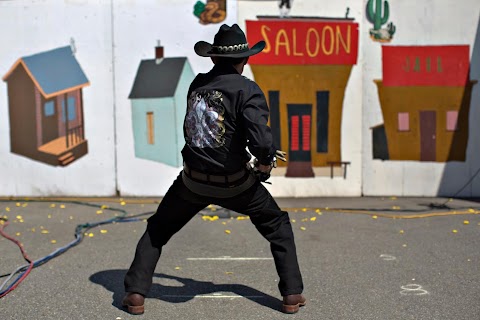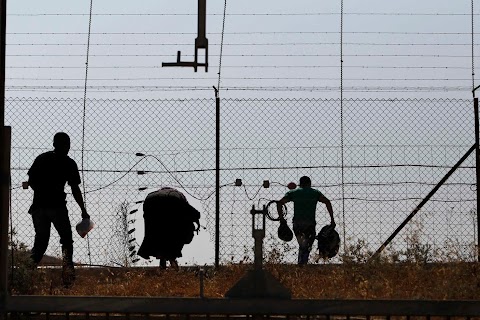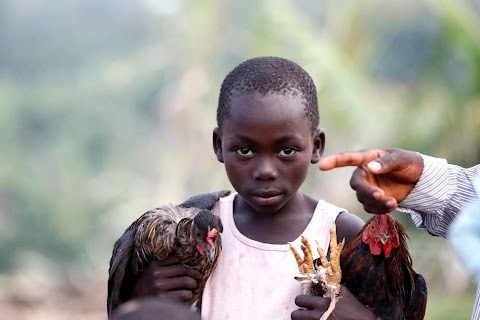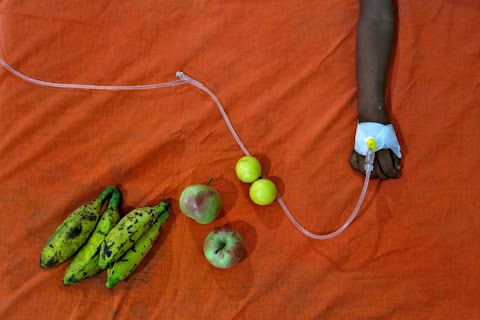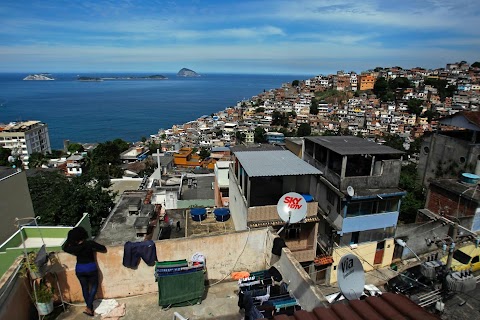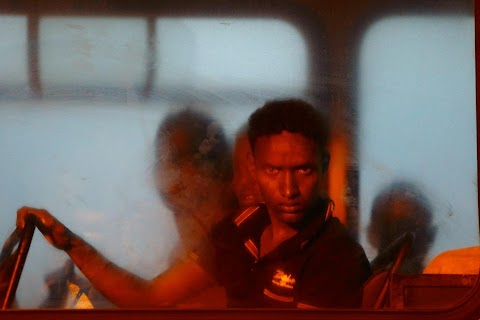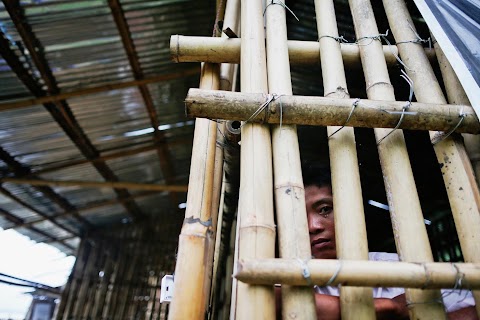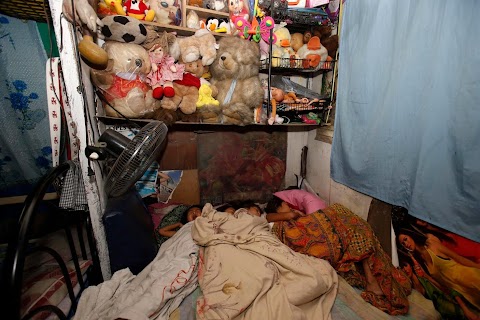
Mind the wealth gap
 Erik De Castro
Erik De Castro
Four sisters sleep crowded together at their home in a squatter colony in the Philippines – a country where the economy is booming, but not everyone is feeling the same benefits. In recent years the wealthy have been seeing their incomes rise significantly faster than the rest of the population, according to the Secretary General of the state statistics organisation, and in the first half of last year, more than a quarter of the country's population were still living in poverty.

Thirty-eight-year-old Arnold Bolata is the father of the four little girls, pictured sleeping in the previous image. He is a tricycle taxi driver, who lives with his family in a two-bedroom shanty in Quezon City, north of the capital Manila.
His wife works as a street food vendor and part-time cook, and together they earn about 20,000 ($462) pesos a month – just enough to feed themselves and their children and pay for basic household expenses.

Thirty-five-year-old Aaron Kasilag is also a father of four. He works as a senior marketing consultant at a multinational company, and lives with his family in the wealthy Ayala Alabang subdivision of Las Pinas, south of Manila. The family has a two-storey house, owns three cars and employs five housemaids.
Slideshow

Arnold Bolata and his wife Nancy pose for a photograph in their living room along with their four children (left to right): MaryJoy, MaryJane, MaryJasmine and MaryAngel.

Nancy Bolata cooks rice at the house.

Left-overs from the previous night's dinner - rice mixed with noodles, dried fish and egg - are set out on the Bolata's table.

Nancy shops for dried fish at a convenience store.

She sits down to get a pedicure at a roadside beauty stall in the squatter colony.

She also gets a manicure by the side of the road.

Nancy's husband Arnold Bolata fills his motorcycle with petrol outside their home.

He sings karaoke while a friend dances at a party.

A waiter at a fast-food restaurant takes a picture of the Bolata family as they celebrate Arnold's 38th birthday.

High-rise buildings stand tall behind an area of poor residential housing and squatter colonies in Taguig, southeast of Manila.

The Kasilag family poses together at their home in Las Pinas, south of Manila. Aaron Kasilag (third left) holds his daughter Noelle, his wife Pia (6th left) holds their son Lucio, Isabel and Sergio Kasilag hold the banister, and the family's five housemaids stand further up the steps.

Lucio, the two-year-old son of Aaron and Pia, sleeps in his bedroom.

Four-year-old Noelle Kasilag uses a laptop in her parents' room.

Pia Kasilag shops for groceries with her son and two housemaids at a supermarket in the wealthy area of Las Pinas where they live.

A breakfast of rice, egg and sausage is served on a plastic dish at the Kasilag family home.

A housemaid spoon-feeds three-year-old Sergio.

Aaron Kasilag, who works as a senior marketing consultant, takes a break from work at Bonifacio Global City.

He works on a laptop computer at the office.

Aaron rests inside a steam room at a men's club after work.

Aaron (4th left) poses for a photograph with colleagues at a bar.
"One common goal among both rich and poor families is the desire to provide a good future for their children."
Taking photos of poor people is nothing unusual for me. The poor comprise more than a quarter of the Philippine population of nearly 97 million and they are also the most vulnerable during disasters such as typhoons, landslides and fires that frequently hog the headlines in the country.
Last month the Secretary General of the state agency, the National Statistical Coordination Board, said in an article that the rich were enjoying significantly faster growth in income compared with people from lower income classes. This means that the gap between the country's rich and poor is widening, with the country's booming economy, the fastest-growing in Asia so far this year, benefiting high-income earners more than those from the middle- and low-income classes.
That helped me come up with the idea to juxtapose the lifestyles of the rich and poor in the country through images. I thought in the beginning that it was easy to document the rich/poor divide, but I found out as I was doing my picture story that it was a complex matter.
I spent more than three weeks doing a picture story concentrating on two families with similar ages but from different income classes. I followed each of the two families as they went about their daily activities, spending lots of time with them even during ungodly hours of the day.
I first observed the family of Arnold Bolata, a 38-year-old father of four who works as a driver of a motorcycle taxi or tricycle and his 33-year-old wife Nancy, a street food vendor and a part-time cook at a small soft drinks company.
They own a two-bedroom shanty in a squatter colony in suburban Quezon city, north of the capital Manila. Arnold and Nancy met in the same neighbourhood 11 years ago. All their four children study at a public school, where they pay only 100 pesos ($2.3) for each child annually as a required school contribution.
Arnold works 16 hours a day with only Sunday off, and plies the streets even in the rain. Nancy sells a sweet banana snack which she herself cooks. They earn a combined income of about 20,000 pesos a month ($462), just enough to put food on the table three times a day and pay for their household expenses.
I immediately noticed upon entering the Bolato family house that more than a dozen of their children's school achievement medals were prominently displayed on their plywood walls.
"We live a hand-to-mouth existence daily," Arnold said, "I only pray my wife and I don't get sick."
Arnold says he is looking forward to finally paying off the loan he got for the motorcycle he is using, as that would lift a big burden from his family's finances. That is progress for us, he said. We are still not losing hope.
To relax after a week of peddling food in the streets and walking 5 kilometres a day to fetch their children from school, Nancy gets her nails done on the sidewalk of a busy highway. She told me that having a manicure and pedicure freed her from stress.
I next watched the family of Aaron Kasilag, a 35-year-old father of four who works as a senior marketing consultant in a multinational company dealing with E-Commerce. His wife of seven years, Pia, a 39-year-old former corporate manager in an international airline company, has decided to become a full-time mother while occasionally dabbling in the food catering business.
Their two-storey house in an upscale subdivision south of Manila has five rooms, and five toilet and bathrooms. They have five housemaids and three cars. They pay a combined annual tuition fee and other school expenses of 250,000 pesos ($6000) for their two older kids who go to a private, exclusive school.
Their third child, a three-year-old boy, is enrolled in a private day-care centre inside the subdivision, while their youngest child is a toddler. The three young children speak to me in fluent English, and have manners like grown-up kids.
"Our combined income is six digits and I am saving 10 percent of that every month," Aaron said. "I was able to buy a car after two years in my present job. I think that's progress and I'm saving more now for my next car."
"I share my dream in life with my wife, which is to give a comfortable life to our children," he says.
To relax after a busy day, Pia often goes to the supermarket with her three-year-old son. They are followed by two housemaids who push another shopping cart with the groceries.
One common goal among both rich and poor families is the desire to provide a good future for their children. Parents want to spend quality time with their kids, and instil good values in them.
But the path to achieving these goals are paved differently for the high-income and low-income classes. In my opinion, the government should provide more opportunities for the poor to benefit from the country's rapid growth.
